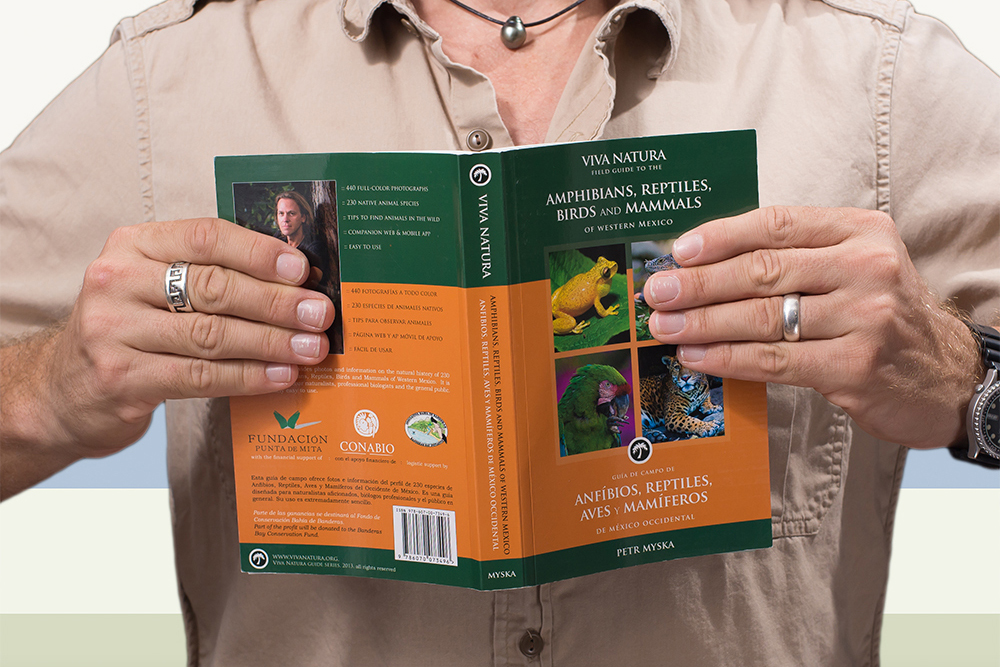- 230 species
- 440 color photos
- bilingual – English/ Spanish
- easy to use
- companion mobile APP
In this second edition there are 230 species in this guide and a total of 440 full-color photos. The guide is extremely easy to use. The book is completely bilingual (English and Spanish). The book commences with a brief introduction to the study area, its geography, climate and ecosystems. Chapters dedicated to the four groups of fauna (amphibians, reptiles, birds and mammals) follow. Each chapter begins with an introduction followed by photographic plates that depict conspicuous species of the study area.
All photos were taken by the author himself and with few exceptions, show animals in their natural habitat under completely natural conditions. Each species is described by both its common and scientific names and also by a set of icons that illustrate the species characteristics, such as its habits, diet, preferred habitat, protection status, ect.
Color bands on the outer edge of each species plate indicate one of the three principal habitat types (Ocean, Coast and Islands, Freshwater, Forest and Gardens) where this particular species can be observed most frequently. Silhouette thumbs on the plates edges portray a typical member of each group of fauna, making browsing the guide more efficient. The final chapter of the book is dedicated to the conservation issues inside the study area.
The book is supported by a companion mobile app where additional texts, photos and also sounds and distribution maps can be found.
[blockquote text=”Viva Natura, field guide to the Amphibians, Reptiles, Birds and Mammals of Western Mexico” show_quote_icon=”yes”]
Review
Note: First edition review (2009)
Very nice, rounded reference to 160 species to Puerto Vallarta, This review is from: Viva Natura: Field Guide to the Amphibians, Reptiles, Birds and Mammals of Western Mexico (English and Spanish Edition) (Perfect Paperback) Basics: 2007, 248pp, softcover; 325 very good color photos of 85 birds, 17 mammals, 39 reptiles, and 18 amphibians; no text other than the species name; 23 types of icons used to denote the species diet, habits, and activities; chapters on climate, conservation, and habitats This is a great local photo guide that focuses on the Puerto Vallarta area of western Mexico. In all, about 160 species of birds, mammals, reptiles, and amphibians are shown in 325 very nice color photographs. These photos make up the bulk of the book and offer the visiting naturalist a solid visual resource to the local fauna. Each of the four categories of animals provide a very nice selection of species. The breakdown of each category is the following: Birds: 150 photos of 85 species (of the 300 in the area) Mammals: 35 photos of 17 species (of the 100 in the area) Reptiles: 77 photos of 39 species (of about 120) Amphibians: 40 photos of 18 species (of the 40-50) All of the photos are of top quality and show the animal very well. There are typically two photos per page, meaning each subject takes up a half-page. This produces nice sized photographs. Some of the subjects are even shown in a full page. Many of the species are shown with multiple photographs that help display the variations between races, ages, or genders. One particular attribute about this book that is appealing (to me) is the presence of good photos of bird and reptile species that are not easily found published elsewhere. Examples that caught my attention where the Colima Pygmy-Owl, Elegant Quail (3 photos), and Stripe-headed Sparrow as well as the Many-lined Whiptail. There is very little text to go with the photographs which consists of the English, Spanish, and scientific names, the animal s length in cm, and a large assortment of symbols. These symbols represent 23 different types of diet, habits, and activities for the species. Some examples would be arboreal, lowland, venomous, diurnal, egg diet, fruit diet, migratory, resident, etc. To better understand these symbols, you ll need to review the page that precedes each of the four animal groups. Accompanying the legend for the symbols are 1-2 pages that generally discuss the natural history of the groups. This includes a range of habitat types that are occupied and the number of species in the area. A nice touch is providing a list of specific localities to explore for various species. Anyone who s an outdoor enthusiast and naturalist will like this book for its excellent photos and for the broader scope of the book. Taking a hike through the Puerto Vallarta area will be more enjoyable and informed with this book. —written by Jack at Avian Review / Avian Books, December 2009
Note: First edition review (2009)
This is an amazing photographic guide of the most common fauna of Western Mexico. It is very useful for tourists visiting Puerto Vallarta, Mexico during vacations. A great part of the species mentioned in this book can be observed just by opening the window of your hotel. That’s because Puerto Vallarta is surrounded by the beautiful Tropical forest. The guide give some interesting information of fauna seeing places in Western Mexico and some facts about the species. This book gives a great visual pleasure. —written by Fabio Cupul Magana (2007)

